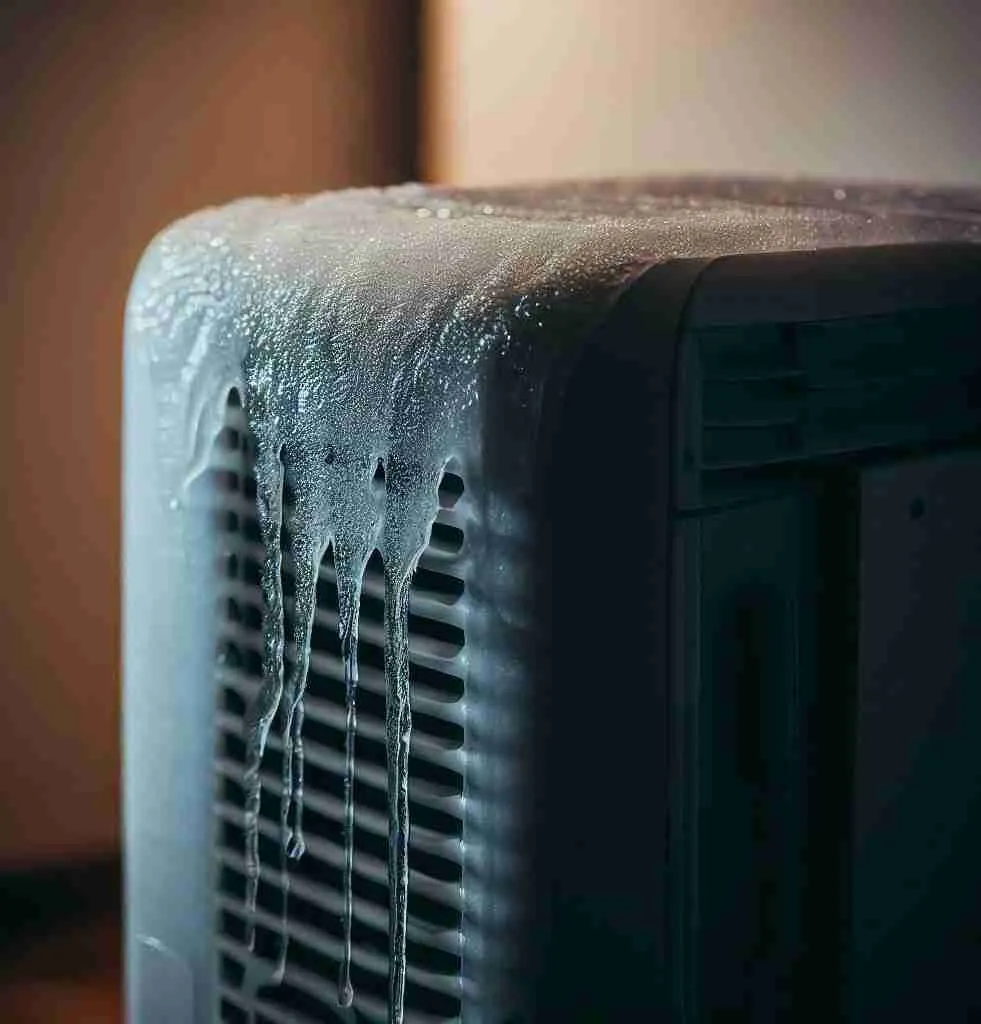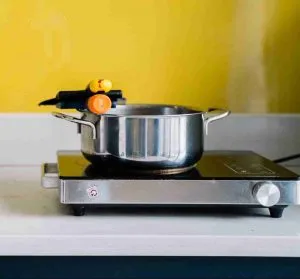Contents
ToggleCauses of Dehumidifier Icing Up
Low Air Temperature: A Common Culprit
A frequent cause of dehumidifier icing up is low air temperature in the room where the dehumidifier operates. The working principle of a dehumidifier involves drawing in moist air, cooling it down to condense moisture, and then releasing the drier air back into the room. When the room temperature is too low, the moisture in the air can freeze upon contact with the cold evaporator coils, leading to ice buildup. This scenario is particularly prevalent in basements and bathrooms, where temperatures are typically lower than in other parts of the house.
To better understand how to manage humidity in these spaces and maintain optimal conditions for your dehumidifier, refer to Basement Humidity and Walkout Basement.
Airflow Issues: The Importance of Circulation
Another potential cause of dehumidifier icing up is restricted airflow. When the dehumidifier doesn’t receive adequate air circulation, the evaporator coils can become excessively cold, leading to ice formation. Several factors may contribute to this issue, including a dirty or clogged air filter, blocked vents, or a malfunctioning fan. Restricted airflow prevents the dehumidifier from operating efficiently, which can further exacerbate the problem of ice buildup.
To ensure proper airflow, it’s crucial to regularly inspect and clean the air filter, clear any obstructions from vents, and address any fan-related issues promptly.
Humidity Sensor Issues: The Role of Accurate Readings
Dehumidifiers depend on humidity sensors to gauge the moisture levels in the air and determine when to cycle on and off. If the sensor isn’t functioning correctly, it may cause the dehumidifier to run continuously, resulting in the evaporator coils becoming too cold and icing up. Inaccurate humidity readings can also lead to over-dehumidification, making the air uncomfortably dry and potentially damaging furnishings and building materials.
In cases where the humidity sensor is malfunctioning, replacing the sensor should resolve the issue. Make sure to consult your dehumidifier’s manual or contact the manufacturer for guidance on how to replace the sensor and recalibrate the unit if necessary.
Symptoms of Dehumidifier Icing Up
Ice Buildup on the Coils: A Telltale Sign
The most apparent symptom of a dehumidifier icing up is the visible presence of ice on the evaporator coils. When these coils become excessively cold, the moisture in the air freezes upon contact, creating a layer of ice. Over time, this ice buildup can grow thicker and more extensive, further impeding the dehumidifier’s ability to function effectively. It’s essential to address this issue promptly to prevent damage to the coils and maintain a comfortable humidity level in your space.
Reduced Airflow: The Impact of Ice on Circulation
As ice accumulates on the coils, it can obstruct airflow through the dehumidifier. This restriction can lead to a noticeable decrease in the volume of air being drawn into the unit and released back into the room. You may observe that the air coming out of your dehumidifier feels weak, less forceful, or barely detectable. If you experience these symptoms, it’s essential to inspect your dehumidifier for ice buildup and take appropriate action to resolve the issue.
Decreased Dehumidification Performance: Struggling Against Humidity
A dehumidifier that’s icing up will experience a significant reduction in its ability to remove moisture from the air. This decrease in performance can be especially problematic in areas prone to high humidity, such as bathrooms and basements, where excess moisture can lead to mold and mildew growth. If you find yourself continually dealing with mold and mildew even though you’re running your dehumidifier, it’s time to check for ice buildup on the coils and take steps to address the problem.
For expert tips on eliminating mold, check out our informative article on how to get rid of mold in the bathroom ceiling. By addressing dehumidifier icing up and tackling mold and mildew growth, you can ensure a healthier and more comfortable environment in your home.
Effects of Dehumidifier Icing Up
Reduced Efficiency
When a dehumidifier ices up, its efficiency in extracting moisture from the air drops significantly. To achieve the same level of dehumidification, your dehumidifier has to work harder and run for more extended periods. This extra effort results in increased energy consumption, leading to higher utility bills. Furthermore, a less efficient dehumidifier will struggle to provide the optimal comfort levels you desire, causing your space to feel damp, musty, and uncomfortable.
The decline in efficiency can also exacerbate existing issues with mold and mildew growth, which can negatively impact your home’s air quality and pose health risks for you and your family.
Increased Energy Consumption
As previously mentioned, a dehumidifier that’s icing up will need to exert more effort to remove moisture from the air. This added strain on the unit translates into increased energy consumption, which can put a dent in your wallet. Higher energy consumption is not only harmful to your budget but also detrimental to the environment. Conserving energy and promoting eco-friendly practices starts at home, and addressing issues like dehumidifier icing up is a step in the right direction.
Potential Damage to the Dehumidifier
Over time, the accumulation of ice on the evaporator coils can cause significant damage to your dehumidifier. The weight of the ice may bend or even break the coils, resulting in costly repairs or the need for a complete replacement of the unit. In some cases, the damage may be severe enough to render the dehumidifier inoperable, leaving you with no choice but to purchase a new one.
Additionally, the extra strain on the dehumidifier’s components due to decreased efficiency can shorten the unit’s lifespan. The added wear and tear on parts like the fan motor, compressor, and electronic components may lead to premature failure, further compounding the costs and inconvenience associated with a dehumidifier that’s icing up.
How to Fix a Dehumidifier That Is Freezing Up
Checking the Humidistat
The first step in fixing a dehumidifier that’s icing up is to check the humidistat, which controls when the dehumidifier turns on and off based on the humidity level in the room. Ensure that it’s set at an appropriate level; too low of a setting can cause the dehumidifier to run continuously, leading to icing up. Adjust the humidistat to a higher setting and see if the issue resolves itself.
 | SMARTRO SC42 Professional Digital Hygrometer | CHECK PRICE |
 | KJCOOSWI 2.7in Indoor Digital Thermometer Temperature Gauge Humidistat Hygrometer | CHECK PRICE |
 | DOQAUS Digital Hygrometer | CHECK PRICE |
Replacing the Filter
A dirty or clogged filter can restrict airflow through the dehumidifier, leading to ice buildup on the coils. Check the filter and replace it if necessary. Regularly changing the filter is a simple maintenance task that can help prevent dehumidifier icing up and improve the overall performance of the unit.
Cleaning the Coils
If the filter is clean and the humidistat is set correctly, but your dehumidifier is still icing up, the coils themselves may be dirty. Dirt and debris on the coils can reduce their ability to transfer heat, leading to ice formation. Carefully clean the coils using a soft brush or cloth, making sure not to damage them in the process.
 | 4 Pieces Air Conditioner Condenser Fin Cleaning Brush | CHECK PRICE |
 | 28 Inch (71cm) Premium Belgian Flexible Medium-Soft Natural Goat hair Coil cleaner | CHECK PRICE |
Ensuring Proper Airflow
Finally, make sure there’s adequate airflow around the dehumidifier. Ensure that vents and grilles are clear of obstructions and that the unit is not placed too close to walls or furniture. Proper airflow is essential for optimal dehumidifier performance and can help prevent icing up.
Preventing Dehumidifier Icing Up
Maintaining Proper Room Temperature
One of the best ways to prevent your dehumidifier from icing up is to maintain a proper room temperature. If possible, try to keep the room temperature above 60°F (16°C), as colder temperatures increase the risk of icing up. If you’re using a dehumidifier in a basement or other colder space, consider adding insulation or using a space heater to maintain a higher temperature.
 | Sunnote Space Heater for Indoor Use, 1500W | CHECK PRICE |
 | Kismile Small Space Heater 750W/1500W | CHECK PRICE |
 | Lasko Oscillating Digital Ceramic Tower Heater 1500W | CHECK PRICE |
Ensuring Proper Airflow
As mentioned earlier, proper airflow is crucial for preventing dehumidifier icing up. Keep the filter clean and regularly check the vents and grilles for obstructions. Additionally, make sure there’s enough space around the unit for air to circulate freely.
Regular Maintenance
Performing regular maintenance on your dehumidifier can go a long way in preventing icing up. In addition to checking the filter and cleaning the coils, inspect the humidistat, fan, and other components for signs of wear or damage. Regular maintenance not only helps prevent icing up but also extends the life of your dehumidifier and ensures optimal performance.
To keep your dehumidifier in tip-top shape, consider creating a maintenance schedule that includes the following tasks:
- Changing the filter every three to six months, or more frequently if the environment is particularly dusty or dirty
- Cleaning the coils at least once a year, or more often if needed
- Inspecting the humidistat, fan, and other components for any signs of wear or damage
- Checking the airflow around the unit and making sure vents and grilles are clear of obstructions
By taking these steps, you’ll be well on your way to preventing dehumidifier icing up and ensuring a comfortable, humidity-free environment in your home.
FAQ:
Is it normal for a dehumidifier to ice up?
It’s not uncommon for a dehumidifier to ice up, especially when operating in colder environments like basements. However, it’s essential to address the issue to prevent decreased efficiency, increased energy consumption, and potential damage to the unit.
What does it mean when your dehumidifier freezes up?
When a dehumidifier freezes up, it means that ice has formed on the evaporator coils due to factors like low air temperature, restricted airflow, or humidity sensor issues. The ice buildup reduces the dehumidifier’s ability to remove moisture from the air, affecting its performance and efficiency.
Why is my dehumidifier coils icing up?
Dehumidifier coils may ice up due to low room temperature, restricted airflow caused by dirty filters or blocked vents, or malfunctioning humidity sensors. These issues cause the coils to become excessively cold, leading to ice formation and impacting the dehumidifier’s performance.
Will freezing damage a dehumidifier?
Yes, freezing can damage a dehumidifier. The ice buildup on the evaporator coils can bend or break the coils, leading to costly repairs or the need for a replacement. Additionally, the extra strain on the unit’s components due to decreased efficiency can shorten its lifespan and cause premature failure.
Wrapping It Up
In conclusion, dehumidifier icing up is a common issue that many homeowners face, particularly in basements and bathrooms where the temperature is often lower. Understanding the causes, symptoms, and effects of this problem can help you identify and address it promptly. Regular maintenance, maintaining proper room temperature, and ensuring proper airflow are key strategies to prevent your dehumidifier from icing up.
Don’t let dehumidifier icing up get in the way of your battle against humidity. Follow the tips and advice in this article to keep your dehumidifier running smoothly and efficiently. And if you’re in the market for a new dehumidifier or looking to upgrade, don’t forget to check out our list of Top Dehumidifiers to find the perfect one for your needs. With the right knowledge and care, you can keep your living space comfortable, dry, and free from mold and mildew.
























































